ВУЗ: Казахская Национальная Академия Искусств им. Т. Жургенова
Категория: Книга
Дисциплина: Не указана
Добавлен: 03.02.2019
Просмотров: 17274
Скачиваний: 51
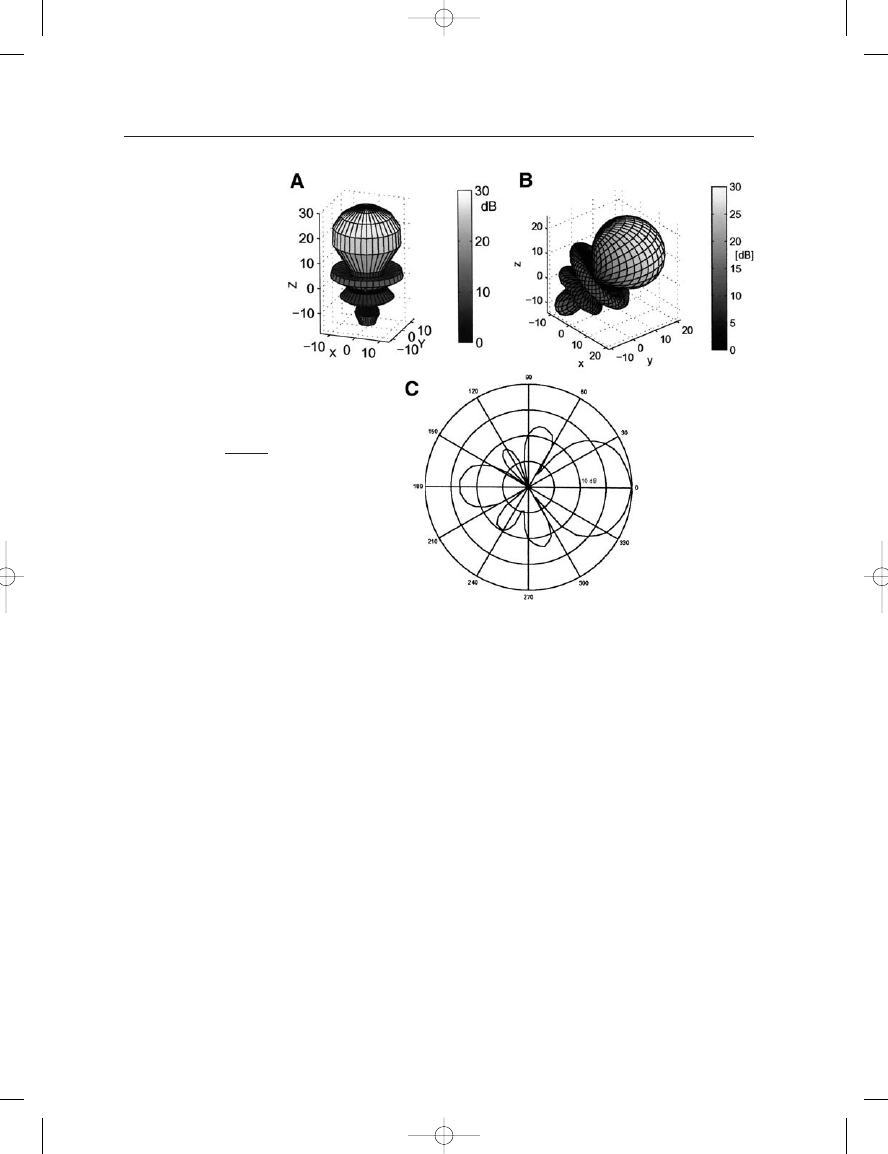
In a manner analogous to the A and B formats that used in the
Soundfield microphone, the outputs of the multiple elements are com-
bined in two stages. The resulting flexibility here allows Eigenbeams, or
directional microphone elements, to be formed continuously over the
sphere independently of the number of actual sensors. Figure 15–21A
shows a synthesized third-order hypercardioid pattern in three dimen-
sions and positioned along one axis. At B is shown the same pattern posi-
tioned at
and angles, each of 20. A two-dimensional view of the
pattern for 3 kHz is shown at C.
In a typical application involving an array intended for sound
field reconstruction, third-order patterns would maintained above
about 1.5 kHz. At progressively lower frequencies the directivity
would be reduced to second-order and finally, below 700 Hz, to first-
order. The compromise here is between spatial resolution and LF noise,
as discussed in Chapter 6. Alternatively, the entire array size can be
increased to offer a better set of tradeoffs between pattern control and
noise at LF.
In addition to audio applications the array has great promise in
acoustical architectural measurement applications, where multichannel
recording can be used to store multiple impulse data for later directional
analysis off-line.
15: Surround Sound Microphone Technology
263
FIGURE 15–21
Formation of Eigenbeams:
third-order pattern along one
axis (A); third-order pattern at
and each of 20 (B); a
two-dimensional polar
plot of a third-order
hypercardioid pattern at
3 kHz (C). (Data courtesy of
Meyer and Agnello, 2003.)
Earg_15.qxd 14/9/04 2:57 PM Page 263
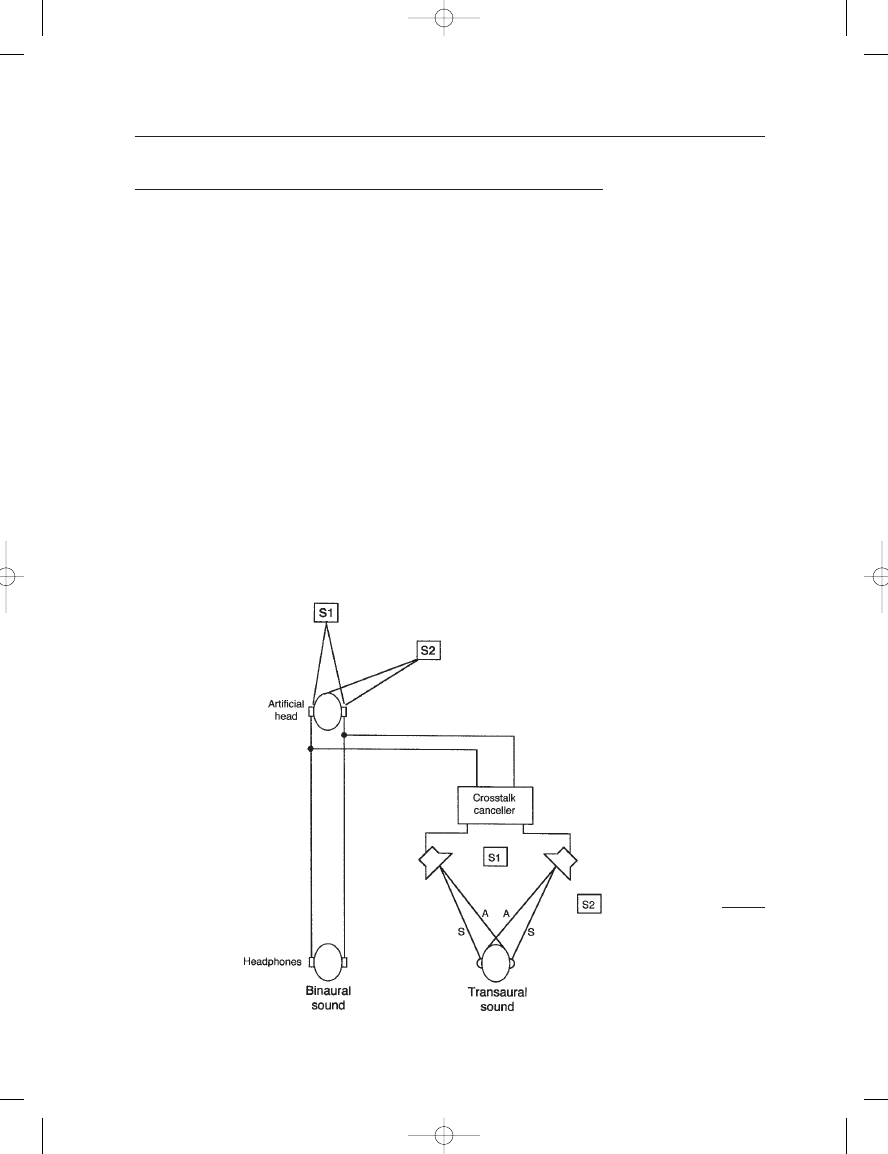
TRANSAURAL (HEAD RELATED) TECHNIQUES
Cooper and Bauck (1989) use the term transaural to describe sound
recording and reproduction systems in which the directional response is
determined by conditions existing independently at the listener’s ears. By
comparison, normal stereo reproduction is defined principally in terms
of what comes out of the loudspeakers, and of course the sound from
each loudspeaker is heard by both ears.
Transaural recording and playback is a direct outgrowth of binaural
sound, which we discussed in Chapter 12. The basic plan is shown in
Figure 15–22, where the two channels of sound picked up by an artifi-
cial head are fed through a crosstalk canceller. In this stage, delayed sig-
nals from each loudspeaker are cross-fed and arrive at opposite ears with
the exact delay time required to cancel the normal stereo leakage, or
crosstalk, signals.
The details of the Schroeder-Atal crosstalk cancelling circuit are
shown in Figure 15–23, where the binaural signal pair is transformed by
the two signals labeled C, where C
A/S. S and A are, respectively, the
transfer functions from the loudspeakers to listener for the near-side
signal (S) and the far-side signal (A) at the ears. The performance of the
crosstalk-cancelling circuitry is normally set for a given listening angle
(
), and the system’s cancellation performance will be optimum for
THE MICROPHONE BOOK
264
FIGURE 15–22
Transaural technology:
a binaural signal can
be played back directly via
headphones or over a pair
of loudspeakers using
crosstalk cancellation.
Earg_15.qxd 14/9/04 2:57 PM Page 264
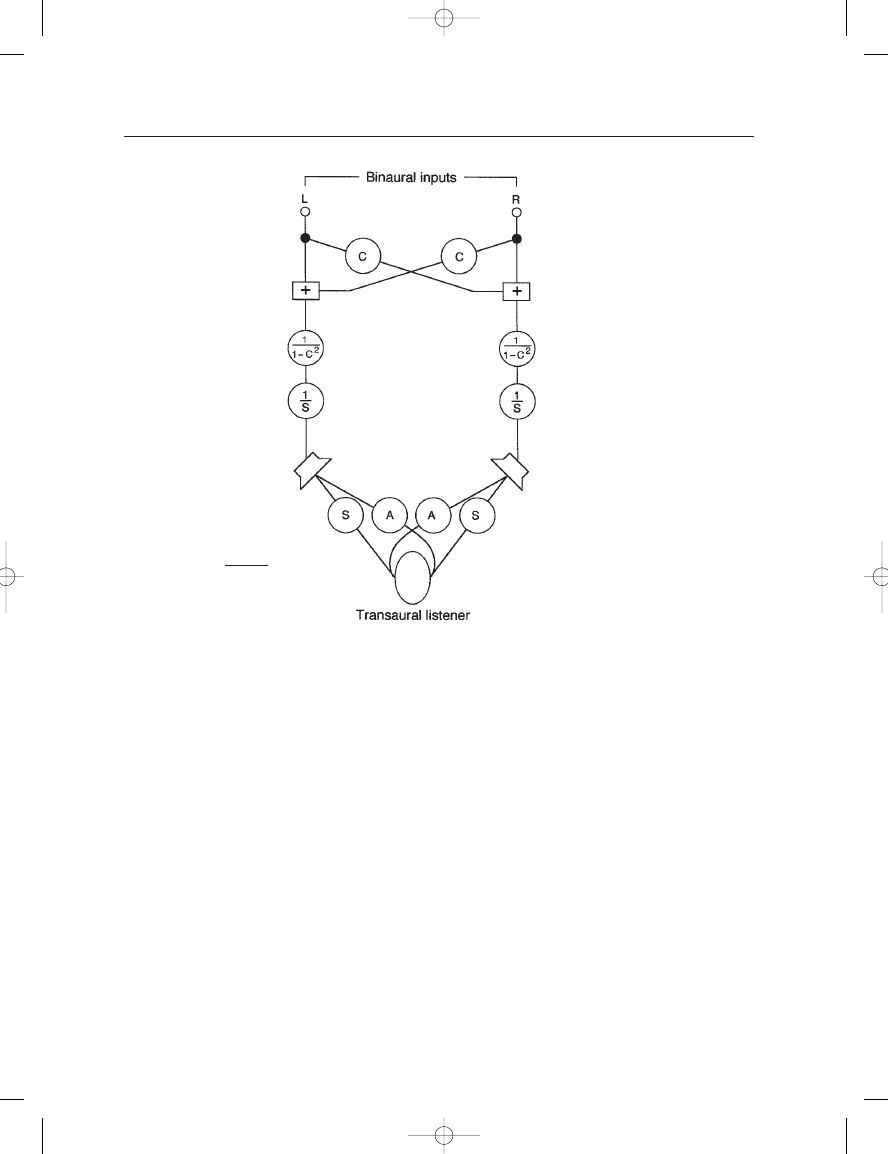
loudspeakers positioned at that angle. Off-axis listening, or listening on-
axis at other angles, will result in non-optimum performance.
Transaural processing works most convincingly when the A and S
data are actually the same as those measured for a given listener – that is,
when the listener’s head is actually substituted for the artificial head in
making the measurements. Generally, however, measurements made on a
typical artificial head will give results that are a good approximation to
the shape of an average adult head. In some laboratory playback sys-
tems, individual head-related transfer functions (HTRFs) can actually be
accessed for improved performance.
For studio use Cooper and Bauck have developed the panning sys-
tem shown in Figure 15–24. Using impulse response methods, the
HTRFs for a given head are measured at each desired azimuthal position
about the head (A). These measurements are stored and can be intro-
duced into a panning system (B) that will translate a given input signal
to a specific position over the frontal 180
listening arc as perceived by a
listener. Positioning can be synthesized for each 5
angular increment.
Using a system such as this, a two-channel transaural presentation
can be generated from a five-channel surround program in which the
listener will hear each of the five channels originating from its proper
15: Surround Sound Microphone Technology
265
FIGURE 15–23
Details of the
Schroeder-Atal crosstalk
cancellation network.
Earg_15.qxd 14/9/04 2:57 PM Page 265
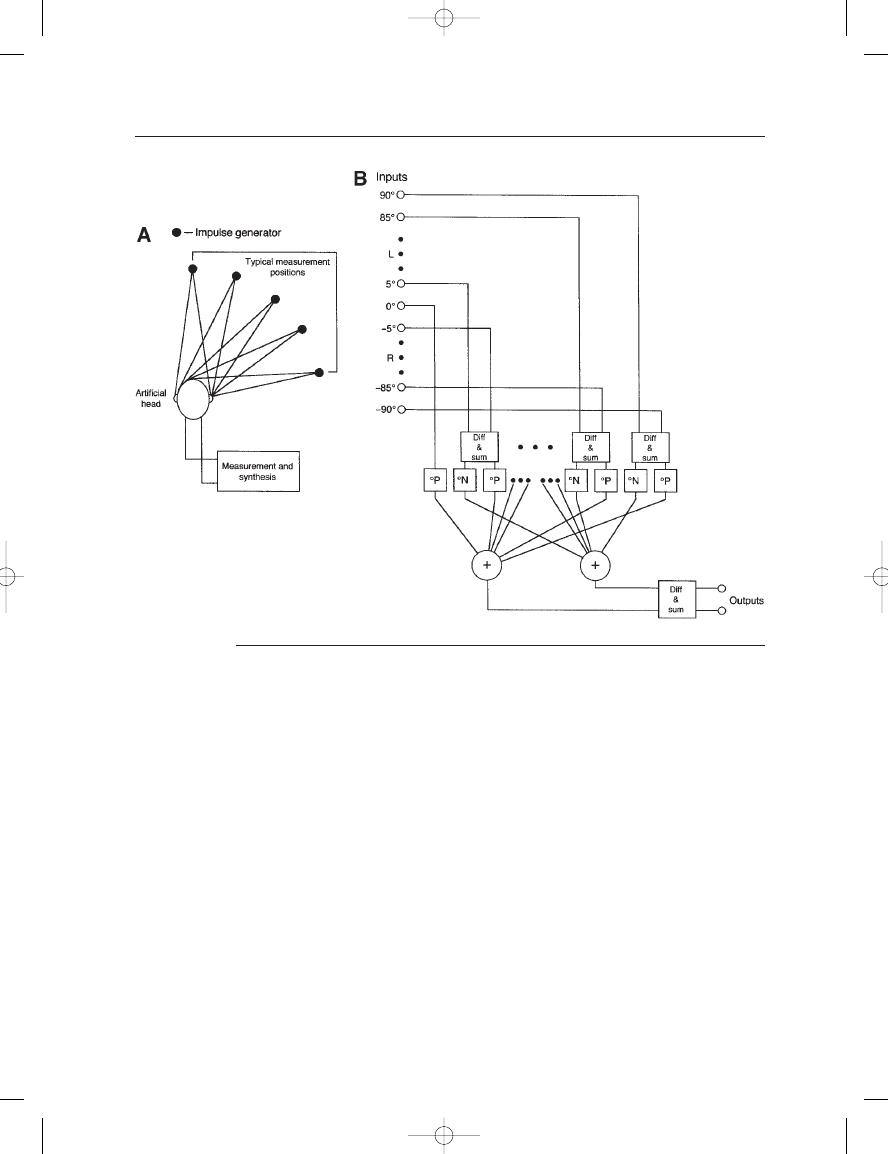
position in virtual space. The effect we have described is as shown in
Figure 15–25.
A note on performance: transaural virtual images are only as stable
as the listener’s head is stationary. A pair of loudspeakers is required for
each listener, and if listeners move their heads from side to side, the vir-
tual images will move with them. With the aid of a technique called head
tracking, compensating signals can be fed back to the synthesizer, par-
tially correcting the tendency for the images to move when the listener’s
head rotates from side to side.
The transural technique has great promise when used in conjunction
with computer monitors and television sets. Today, many TV programs
are broadcast in surround sound that has been encoded for transaural
playback. For TV loudspeakers located about 0.5 m (20 in) apart, a lis-
tening distance of approximately 2 m (6.7 ft) will usually suffice to give
the listener a good impression of what transaural techniques can provide.
An on-axis location is critical, and normally only a single listener can
THE MICROPHONE BOOK
266
FIGURE 15–24
Details of a transaural panning scheme: making HTRF measurements (A); overall detail of the panner (B). (Data after
Cooper and Bauck, 1989.)
Earg_15.qxd 14/9/04 2:57 PM Page 266
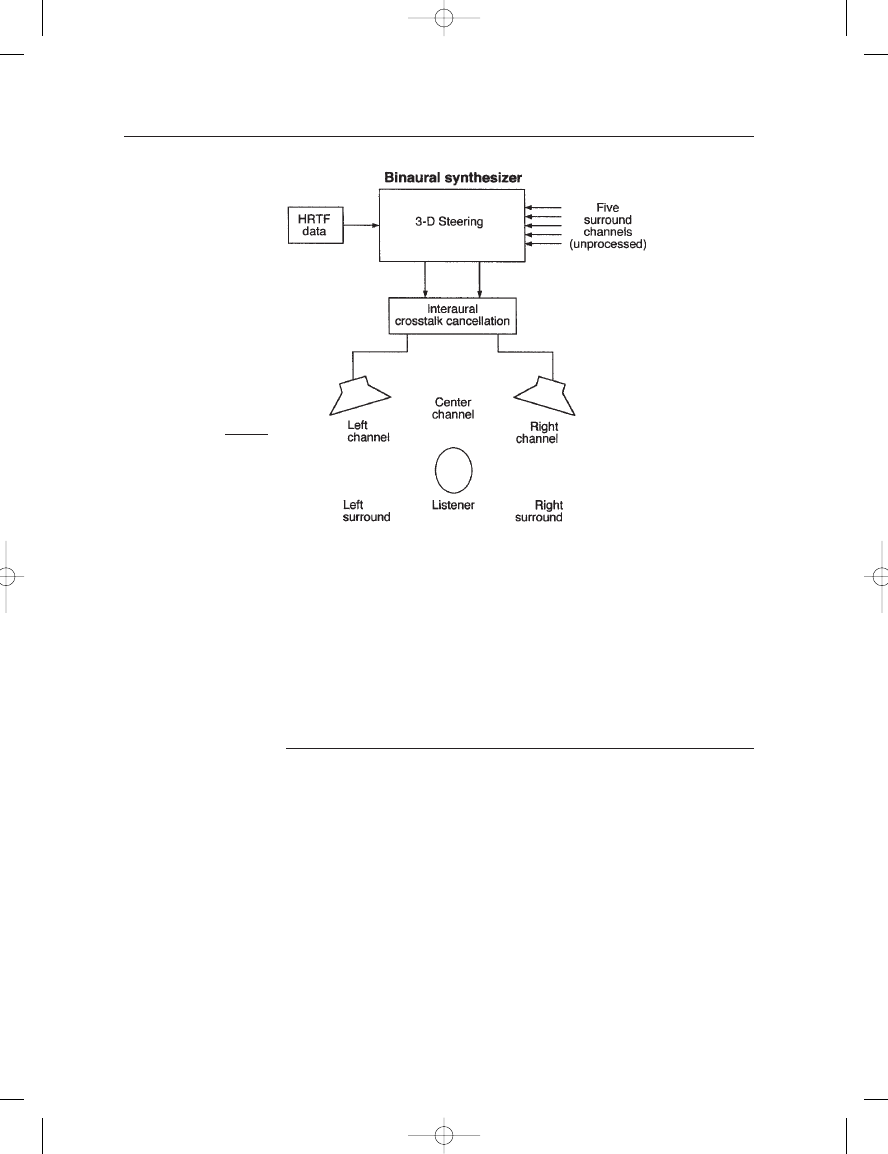
appreciate the effect to the fullest extent. The same technology is often
applied to video games and other computer programs. Here, the viewing
distance is much closer than is the norm for TV, and appropriate adjust-
ments will have to be made.
Transaural systems have generally required extensive internal signal
processing, but the costs of such operations continues to drop, making
them more accessible to modern application in listening environments,
such as computer workstations, where listening positions are stable and
can be accurately estimated.
SYSTEMS WITH PARALLAX
In a landmark paper on motion picture sound technology, Snow (1953)
described the “perfect” record/playback system shown in Figure 15–26.
A horizontal array of microphones communicate, each independently, to
a horizontal array of loudspeakers in the theater environment. A diverg-
ing wavefront at the microphones creates a sequentially firing set of indi-
vidual wavefronts from the loudspeakers which coalesce, via Huygen’s
law on wavefront reconstruction, into a near copy of the original wave-
front impinging on the microphones. We may think of this as an acousti-
cal hologram in which listeners in the theater are free to move around
and hear individual acoustical sources in their proper left-right, fore-aft
relationships – in other words, as fixed in space as real sources.
The hardware requirements are staggering to consider, and such a
system has long been little more than a dream. However, modern tech-
nology has come to the rescue with multiple small loudspeakers, small
15: Surround Sound Microphone Technology
267
FIGURE 15–25
Overall view of a
transaural presentation
of a five-channel surround
program using a stereo pair
of channels.
Earg_15.qxd 14/9/04 2:57 PM Page 267